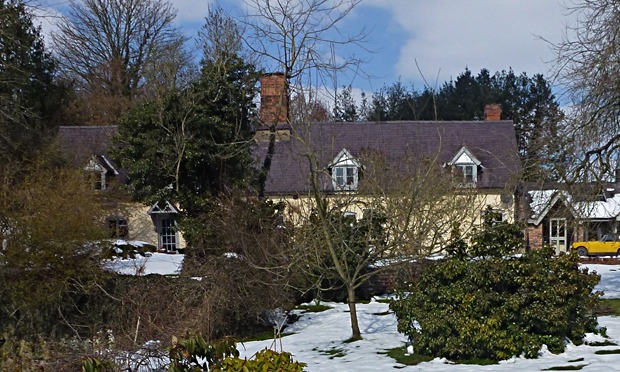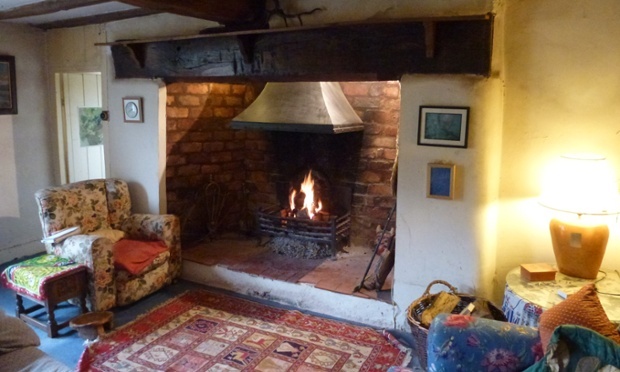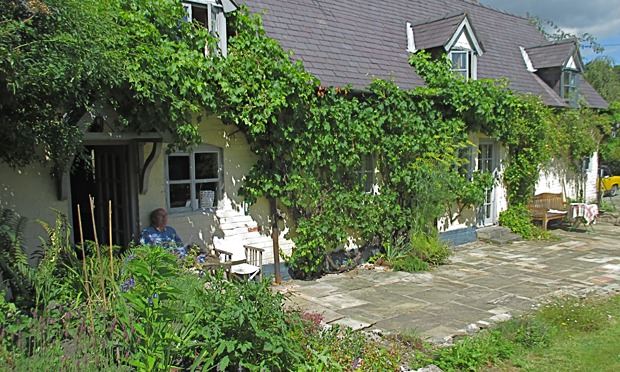Green deal is inappropriate for Britain’s 5m historic homes, so what’s the best way to stop them leaking energy? John Vidal gets expert advice for his Grade II listed home

John Vidal’s home in north Wales is a 350-year-old half-timbered industrial workers’ cottage. Photograph: theguardian.com
Thirty five years ago I bought a row of 350-year-old Welsh half-timbered industrial workers’ cottages. Good move, except for the several kinds of damp, the beetles, woodworm, rotting windows, multicoloured moulds, doors that did not fit and a resident cat.Over the years, nearly everything has been repaired and re-repaired, new bits
have been added, and other bits have dropped off. The cat has long gone and today it’s like so many of Britain’s other 400,000 listed buildings – hungry, expensive to maintain, and a mix of styles, materials and ages. I love it.
But until the ‘Green Police’ – the head of environmental practices at the National Trust, a leading historic buildings adviser and a researcher at the Centre for sustainable energy in Bristol – descended on it recently I did not realise how much energy I was wasting and what could be done.
As the three walked round, I cringed as they clocked the rug blocking the gap below the front door, the 20-year-old old Rayburn, the great open fires burning cartloads of wood, the cracked window glass, uninsulated pipes, and the wind whistling down the stairs and quarry-tiled floors laid 150 years ago with no damp course.
I simpered that one learns to live with faults and it was a case of never having the money to “modernise” a traditionally-built house. “Besides, we just put on extra jumpers when it is cold and, anyway, you keep fit and don’t need much heating when you run around all day chopping logs, don’t you?”

Wood burning in the open fireplace. Photograph: The Guardian
They were dismissive but diplomatic at these pathetically weak arguments, saying: “Bad building is as old as the hills”; “Modern builders get very little training in how to work on old houses”; “You could start by changing behaviour” and: “I did notice that the window in the dressing room was covered in a plastic sheet …”
But they were unanimous that when it came to energy efficiency, Britain’s 5m historic houses – defined by the Society for the Protection of Ancient Buildings as anything built before 1919 – should not be treated like new ones, and that green deal-style modern technologies were often inappropriate.
Indeed, they said, slapping insulation inside or outside solid brick or stone walls, even installing double glazing, might not just be inefficient, unaesthetic and expensive, but could add to damp problems and harm the fabric of an old building. Far better to use natural building materials, heat only what you need and use traditional shutters and heavy curtains, they said.
Old buildings were built to breathe and be heated one room at a time, said Rob Lloyd-Sweet, the historic buildings adviser. “If you insulate the wall on the outside, that could keep the moisture in, causing damp and mould. If you insulate on the inside the wall outside will get colder, possibly making the moisture condense and saturate the wall.”
Lizzy Carlyle of the National Trust, which is in the process of retrofitting 300 historic properties and planning to reduce overall energy use in them by 20% by 2020, was brutal: “Your heating system is uncontrollable, it’s either on in winter or it isn’t. So any efforts to improve air tightness or insulation will undoubtedly make you more comfortable, but may not result in a reduction of energy use and therefore fuel bills.
“I’d get rid of the Rayburn immediately and I’d put a wood-burning stove in your dining area with a back boiler. You can now get a retrofit PV-friendly [solar photovoltaic] immersion switch to give you maximum benefit from your solar panels by allowing you to use the electricity even when you’re not there,” she said (i.e. electricity from the building’s solar panels could heat the water).

The house as it looks in summer. Photograph: theguardian.com
All three advised me to do the common sense things before spending heavily on fancy kit. “Fit draught excluders to your letterbox and outside doors, get heavier curtains, make sure your radiators aren’t blocked by furniture, mend the broken panes of glass, fill in the gaps in the wooden panelling, insulate the loft access hatch, change all lights to LED and up the loft insulation,” they agreed.
Advertisement
“You could install programmable thermostats, consider raising the roof slightly to add insulation, make sure that all heating and hot water pipework is also well insulated,” said Annette Lamley.
“Consider the heritage value of the building, go first for simple energy-saving changes,” said Lloyd-Sweet. “Don’t rush it. Historic buildings can be complicated. Some measures may have less impact than expected, others could do some harm, particularly by trapping moisture.”
Next up, the vexed issue of the oil-fired Rayburn, which, in the absence of gas in the area, burns around 1,600 litres of kerosene a year, cooks and heats all the water and the 12 radiators. Like many others who would love to get off oil, it’s a case of finding £10,000 to replace it with an equivalent wood pellet model or waiting till it claps out, probably in another few years (the renewable heat incentive launched in the spring is meant to help).
“I think it’s quite unlikely that most Rayburn owners will want to rip them out, mostly due to aestheticor cultural reasons and character. There is also an argument that Rayburns are likely to last a long time, so perhaps the carbon emissions emitted over their lifecycle help to even things up a bit (also, as the system is already in place, there are no additional emissions from the manufacture/delivery/installation of a new system), but I believe this is a bit of a contentious issue!”Lamley said.
But Lamley just about forgave the hopelessly inefficient but wonderful open fires. “If you really enjoy sitting in front of the fire and you source your wood fuel from a local sustainable source then perhaps keeping it wouldn’t be so terrible …”

Cats at the door and the red rug blocking the one-inch gap beneath it.Photograph: The Guardian
Top tips
Robert Lloyd-Sweet, historic homes adviser
1. A lot of energy waste in old buildings is the result of overdue maintenance, so get the window panes fixed and clear out the gutters and drains that make walls damp and cold.
2. Do the cheap options that have the least impact on the building fabric first, eg: turning the thermostat down a degree, draught-stripping for windows and doors and a thick pair of curtains can be just as effective as more expensive measures. Floor coverings or rugs can block air infiltration and keep feet warm.
3. Think about how and when you use your building. When does it need
to be warmer and when could it be cooler? Swap your boiler controls from a timer to a programmable thermostat and switch off what you can.
4. Historic buildings were designed to be heated one room at a time using separate open fires, which is more efficient than all at once. You can recreate this today by manually controlling thermostat valves. Programmable wi-fi radiator valves are becoming more readily available.
5. Typically, about 25% heat is lost through the roof, in comparison to 35% through the walls, 15% through the floor and 25% from windows and draughts. But the cost of insulating in the roof is usually much lower than the cost of solid wall insulation, so it is often more cost-effective to do the roof first.
6. For the big investment, focus on how you generate and distribute
heat in your building. Ask for advice while you’re still considering your
options.
Lizzy Carlyle, National Trust
The whole efficiency agenda seem a bit daunting if you’re a traditional home owner, when in fact there are plenty of steps you can take with no or very low risk, which do not require expertise or huge amounts of money.
1. Know what you use and where you use it and switch off what you can.
2. Maintain the building fabric and your heating system.
3. Make sure controls and timers are set correct.
4. Replace incandescent and halogen bulbs with LED ones.
5. Install simple efficiency measures – thick curtains, draught proof strips.
Annette Lamley, Centre for Sustainable Energy
1. Older homes deal with heat and moisture differently to more modern construction types. Look at the property as a whole system rather than considering measures individually and think about their cumulative impact on the way that the building fabric functions.
2. Consider all the simple and cheap measures first, before investing in more expensive measures such as external wall insulation – like draught excluders and heavier curtains. Think about floor coverings or rugs to block air infiltration and keep feet warm.
4. Keeping your home in a good state of repair can make a big difference, and in most cases is likely to maintain or even improve the heritage value of a home.
5. Typically, about 25% heat is lost through the roof, in comparison to 35% through the walls, 15% through the floor and 25% from windows and draughts. But the cost of insulating the roof is usually much lower than the cost of solid wall insulation, so it is often more cost-effective to do the roof first.

